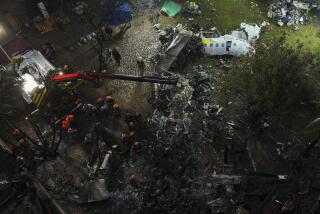Lack of Icing Warning Cited in Plane Crash
- Share via
The failure of the European manufacturer and French aviation authorities to warn about the ATR-72 commuter plane’s instability during icing conditions probably caused the lethal crash of American Eagle Flight 4184 in rural Indiana two years ago, federal officials said Tuesday.
The National Transportation Safety Board said ice built up on the twin-engine turboprop’s wings as the plane circled for 39 minutes in a holding pattern on Oct. 31, 1994, waiting for clearance to land in Chicago.
Federal investigators said the accumulating ice distorted the shape of the aircraft’s wings and control surfaces, creating the instability that caused the plane to nose-dive into a soybean field near Roselawn, Ind., killing all 68 aboard.
In its final report on the crash, the NTSB said Tuesday that the manufacturer--Avions de Transport Regionale--”failed to completely disclose . . . adequate information concerning previously known effects of freezing drizzle and freezing rain conditions on the stability and control characteristics” of the ATR-72.
The report also blamed the French Directorate Generale de l’Aviation Civile’s “inadequate oversight of the . . . ATR-72 and [lack of] necessary corrective action to assure continued airworthiness in icing conditions.”
In a sharply worded response to the findings of the American safety agency, its French counterpart--the Bureau Enquetes-Accidents--expressed “deep disappointment and total disagreement” with the NTSB report.
“The report is unbalanced and ignores critical causal factors, such as crew behavior, that significantly contributed to the accident,” the French bureau said in a statement issued Tuesday evening through France’s consular offices. “It overlooks the fact that the accident occurred as a result of prolonged operation of the aircraft in known icing conditions with severe ice accretion well beyond the certification envelope for all aircraft.”
The manufacturer has redesigned the plane’s de-icing system since the crash and the FAA says the plane is now safe.
More to Read
Sign up for Essential California
The most important California stories and recommendations in your inbox every morning.
You may occasionally receive promotional content from the Los Angeles Times.













